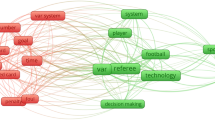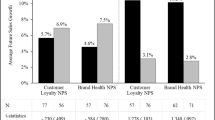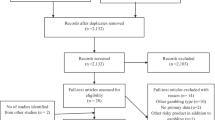Abstract
This paper uses data from Major League Baseball and themes from Moneyball by Michael Lewis to empirically illustrate Kirznerian entrepreneurship. While Kirzner envisioned competition in markets for profit, the sports economics literature shows that sporting competition has things in common with market competition. This is important because a strength of sports economics, namely, the abundant data, can help overcome a perceived weakness of Austrian economics, namely, the lack of empirical content. This paper describes and empirically confirms how certain front office decision makers of the Oakland Athletics were alert to opportunities that were being overlooked by other baseball executives.
Similar content being viewed by others
Notes
The referee pointed out that some advanced textbooks treat innovation, strategy, and change. However, the textbook the referee suggested has only passing reference to Schumpeter, and no mention of Kirzner. The dynamism in the textbook follows directly from the neoclassical method of optimization subject to constraints, considering such questions as who has greater incentive to innovate, an incumbent monopolist or a potential entrant? Such questions are examined in an equilibrium framework. While these questions and the models examining them are interesting, they largely miss the significance of Kirzner's views.
The possible connection to the Goff, McCormick, and Tollison (2002) paper was suggested by the referee.
A possible exception is expenditure on an aging superstar who might not contribute to wins but who might increase attendance due to fan nostalgia. Pele playing in the now defunct North American Soccer League is perhaps an example, athough his skills, if not his stamina, were still considerable. No recent examples in baseball would seem to make a quantifiable difference.
For the most part, batting average is the ratio of safe hits to the sum of safe hits plus outs, the denominator being called official at-bats. On-base percentage adds walks and is hit by the pitch to both the numerator and the denominator. There are other minor adjustments having to do with sacrifices, fielder's choices, and errors.
Lewis (2004) pp. 65–66.
Lewis (2004) pp. 56–57.
Lewis (2004) p. 59.
Lewis (2004) p. 60.
Lewis (2004) p. 60.
Lewis (2004) p. 102.
Paul DePodesta, trained as a economist, was Beane's assistant who brought considerable computing and data management skills to the table. He now works for the Los Angeles Dodgers.
Lewis (2004) pp. 141–142.
Hakes and Sauer (2006) directly test the mispricing proposition with regressions of salaries on relevant skills to estimate the marginal value of each skill. Following the sabermetricians, Hakes and Sauer show that on-base percentage should be more valuable than slugging percentage. (Slugging percentage is a weighted batting average in which doubles receive twice as much weight as singles; triples, three times as much; and home runs, four times as much.) The mispricing is evident in the early years of their sample, 2000–2003, because slugging percentage has a higher coefficient than on-base percentage. In 2004, the magnitude of the coefficients is reversed.
Lewis (2004) p. 294.
Lewis (2004) p. 292.
I thank the referee for suggesting this line of empirical testing.
National League teams would be different because of the lack of the designated hitter.
Outliers are herein defined as data points lying more than two standard deviations from the mean. The three positive outliers were Oakland (1999), Oakland (2000), and New York Yankees (2004). The lone negative outlier was the expansion franchise Tampa Bay 1998.
The z-score for the simple difference in means test was 3.86, significant at the 99% level.
The data were retrieved from www.rodneyfort.com. The website has multiple lists of team salaries that differ when trades take place over the course of the season and in how well they capture incentive clauses. I used the salary figures that were derived from USA Today.
An interesting tangent that does not bear on Oakland's results was the significant negative dummy variables calculated for Baltimore, Chicago Cubs, Detroit, and Tampa Bay. These teams are mismanaged in the sense of getting less for their money than the average team.
Examination of the coefficients of the fixed effects model indicates that the New York Mets were one of the median teams. Using the median team as the omitted dummy variable allows the t-statistic for the included dummy variables to determine whether that team's performance is significantly different from the median of all the teams. In Eq. (2) where only one team is captured in a dummy variable the t-statistic determines whether that team's performance is significantly different from the average of the other team's performances.
Raymond Sauer suggested this analogy.
References
Alchian, A. A. (1950). Uncertainty, evolution and economic theory. Journal of Political Economy, 58(3), 211–221.
Goff, B. L., McCormick, R. E., & Tollison, R. D. (2002). Racial innovation as an innovation: Empirical evidence from sports leagues. American Economic Review, 92(1), 16–26.
Griliches, Z. (1957). Hybrid corn: An exploration in the economics of technical change. Econometrica, 25(4), 501–522.
Hakes, J. K., & Sauer, R. D. (2006). An economic evaluation of the Moneyball hypothesis. Journal of Economic Perspectives, 20(3), 173–185.
Hall, S., Szymanski, S., & Zimbalist, A. S. (2002). Testing causality between team performance and payroll: The cases of major league baseball and english soccer. Journal of Sports Economics, 3(2), 149–168.
Kirzner, I. M. (1973). Competition and entrepreneurship. Chicago: The University of Chicago Press.
Kirzner, I. M. (1994). A tale of two worlds: Comment on Shmanske. In P. J. Boettke & M. J. Rizzo (Eds.) Advances in austrian economics (vol. 1, pp. 223–226).
Lancaster, K. J. (1966). A new approach to consumer theory. Journal of Political Economy, 74(2), 132–157.
Lewis, M. (2004 (2003)). Moneyball: The art of winning an unfair game. New York: W. W. Norton & Company.
Scully, G. (1974). Pay and performance in major league baseball. American Economic Review, 64, 915–930.
Shmanske, S. (1994). On the relevance of policy to Kirznerian entrepreneurship. In P. J. Boettke, & M. J. Rizzo (Eds.), Advances in austrian economics (vol. 1, pp. 199–222).
Acknowledgments
I gratefully acknowledge Rod Fort who maintains the data and makes it available for zero price on his website, www.rodneyfort.com. Helpful comments on an earlier draft were received from Charles Baird, Paul Staudohar, Raymond Sauer and the referee.
Author information
Authors and Affiliations
Corresponding author
Additional information
JEL Codes B53 · L83 · M13
Rights and permissions
About this article
Cite this article
Shmanske, S. Austrian themes, data, and sports economics. Rev Austrian Econ 20, 11–24 (2007). https://doi.org/10.1007/s11138-006-0002-0
Published:
Issue Date:
DOI: https://doi.org/10.1007/s11138-006-0002-0




